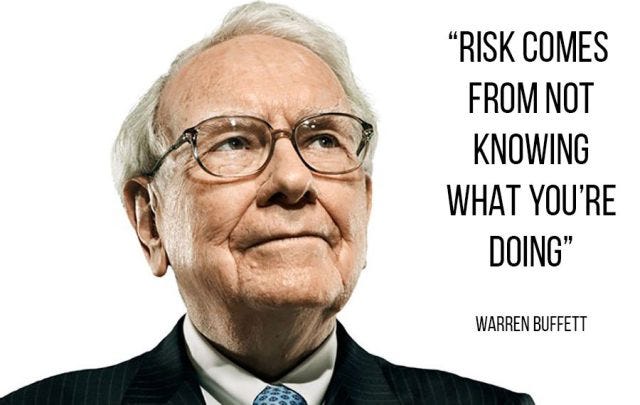Everyone's a Trader
How understanding expected value in daily decisions makes you a better trader
Hey there, Pedma here! Welcome to this ✨ free edition ✨ of the Trading Research Hub’s Newsletter. Each week, I'll share with you a blend of market research, personal trading experiences, and practical strategies, all aimed at making the world of systematic trading more relatable and accessible.
If you’re not a subscriber, here’s what you missed this past month so far:
If you’re not yet a part of our community, subscribe to stay updated with these more of these posts, and to access all our content.
We make trades every day of our lives.
Not just in the markets, but in most “normal life” decisions we take.
Most times we don't even notice it, and that’s how simple decisions can become dangerous.
As Warren Buffett famously said:
"Risk comes from not knowing what you're doing."
While his context was value investing, this quote perfectly captures our article today. Every decision we make - in life or markets - carries different risk to reward profiles.
But that risk increases dramatically when we don't understand the expected value of our decisions.
Let me explain...
Index
The Daily Trades We Make
Understanding Expected Value
How This Applies to Trading
The Professional Trader's Edge
Conclusion
The Daily Trades We Make
It was 6:45 AM when my alarm rang yesterday.
I picked up my phone and spent 30 minutes reading Twitter rather than going straight to my desk.
In trading terms, I traded 30 minutes of productivity (clearing my morning emails) for 30 minutes of comfort.
What was the expected value (EV) of that trade?
Pretty terrible, unless I happened to find an idea worth more than those 30 minutes of focused work.
And I sure didn’t!
By 10 AM, I faced another trade - go to the gym or keep working.
I chose to trade short-term comfort for long-term health benefits. Unlike my morning Twitter scroll, this trade has positive expected value that compounds over time.
I took it, and felt better for it.
I won’t see the results from it right away, but my long-term health will benefit from this positive EV decision.
At noon, I made a different kind of trade - I paid $25 at the local steakhouse instead of spending 1.5 hours cooking. The EV calculation here was straightforward: my time today was worth more than the price I’d pay for the same food already prepared.
This EV calculation would be different had I gone to buy fast food instead.
Even though I’d have saved my time from cooking, I would have made a bad health decision, which would have decreased the EV of that bet.
Later that evening, I paid $50 to my house cleaner instead of spending 4 hours doing it myself.
Here’s how I thought about the trade:
Those 4 hours could be spent coding, writing and studying, which are far more valuable activities to me in the long run. While I take the upfront cost of $50, the time saved and productivity gained made it a clear positive EV decision.
Everything is an EV calculation!
Understanding Expected Value
This is where it gets interesting for us as traders.
Each decision we make - whether in life or markets - has its own risk/reward profile. Some are clearly positive EV, others negative, and many fall into that uncertain middle ground.
But how do we calculate it?
As an example, a restaurant owner knows with high certainty that a $20 plate costing $5 in ingredients will be profitable. But as traders, our edge constantly shifts with market conditions.
The key difference between a restaurant's EV calculation and ours, is how noisy our estimates are.
This is the expected value (EV) formula:
Where:
For every potential trade:
You assign a probability to each possible outcome (e.g., winning or losing).
Multiply the probability by the payoff for that outcome.
Add these products together to get the EV.
Let’s consider an example closer to trading. Suppose you’re evaluating a setup where:
There’s a 40% chance (P=0.4P = 0.4P=0.4) of making $500.
There’s a 60% chance (P=0.6P = 0.6P=0.6) of losing $200.
EV=(0.4⋅500)+(0.6⋅−200)=200−120=80
Here, the EV = $80, meaning this setup has a positive expected value.
Over a large number of trades, you’d expect to earn $80 on average per trade.
In a perfect world, where these variables would be fixed, you’d want to squeeze as much as possible from this edge.
However, as traders, we deal with uncertainty and market noise, so we need to factor in that uncertainty and monitor changes in our edge.
Also while EV is a powerful tool, it has limitations—especially when dealing with non-normal distributions, which are present in financial markets:
Sensitivity to Outliers: Heavy-tailed distributions can have extreme values that disproportionately affect EV. For example, a single large loss in a fat-tailed distribution could make the EV highly misleading.
Non-Symmetric Risk-Reward: Skewed distributions may result in an EV that doesn’t align with the median or most frequent outcomes. For example, a lottery-like trade may have a high EV due to rare, large payoffs, even though most outcomes are losses.
Variance and Risk: EV doesn’t capture the variability or risk of outcomes. Two setups with the same EV can have drastically different risk profiles—one with consistent small gains and another with rare large gains.
Uncertain Probabilities: EV relies on accurate estimates of probabilities, which are often difficult to determine in noisy, dynamic markets. Incorrect assumptions can render the calculation unreliable.
As opposed to a restaurant owner, that can rely on stable inputs and predictable outcomes for EV calculations, we as traders can’t.
Markets are non-stationary and so are our estimates about edge.
For us, recognizing and managing the "noise" in our estimates is part of the job. This is where a well-defined trading edge and systematic approach become invaluable.
I’ve written how to be more confident about edge here:
How This Applies to Trading
The vast majority of trader problems stem from not understanding this concept of expected value.
When traders blame psychology, technical analysis skills, or lack of capital for their failures, they're missing the core issue:
If you're consistently losing money, the expected value of your trading decisions is negative.
It's that simple.
Just like my morning Twitter scroll had negative EV for my productivity, many traders take positions with negative EV too.
Some of the reasons for this counter-productive decision making are:
FOMO entries without edge
Oversized positions that don't account for uncertainty
Trading without understanding costs
Not having a clear thesis about market behavior
If I keep taking the decision of scrolling twitter rather than working, I’ll eventually become much worse at my job than what I could be.
Similarly, the trader that continues to take negative EV trades, will continue to lose money and blame abstract concepts that have very little to do with his lack of profitability.
You need to become a master at understanding the EV of your decisions!
The Professional Trader's Edge
What separates professional traders from novices isn't just experience - it's their approach to uncertainty.
Professionals understand that:
Every position must have positive expected value after costs
Edge estimates are noisy and constantly changing
Position sizing must account for uncertainty
Consistent profitability comes from making +EV decisions repeatedly over many years.
Just like my decision to outsource house cleaning for $50 to focus on writing this article, we have to make deliberate tradeoffs based on expected value.
Next time you're about to enter a trade, think about it like any other decision in your life:
What am I trading? (Capital, time, opportunity cost)
What do I expect in return?
How certain am I about this expectation?
Does this trade make sense after accounting for costs and uncertainty?
Trading isn't just about charts and indicators - it's about making smart decisions despite uncertainty.
The better you get at evaluating expected value in all areas of life, the better trader you'll become.
I wish you a great day!
Ps… Looking to Work With Me?
After testing 100’s of trading strategies and spending 1,000’s of hours studying trading and building my own models, I had a few clients reach out to work with me and the outcomes have been quite good so far!
I’ve helped multiple clients now:
Develop their first systematic model
Help reviewing their current trading processes
Build solid frameworks on trading system development
Stop wasting money and time on bad ideas
Develop better risk management models
And much more…
If you want my custom help on your trading business, or would like to work with me, book a free 15-minute consultation call:
And finally, I’d love your input on how I can make Trading Research Hub even more useful for you!
Disclaimer: The content and information provided by the Trading Research Hub, including all other materials, are for educational and informational purposes only and should not be considered financial advice or a recommendation to buy or sell any type of security or investment. Always conduct your own research and consult with a licensed financial professional before making any investment decisions. Trading and investing can involve significant risk of loss, and you should understand these risks before making any financial decisions.








